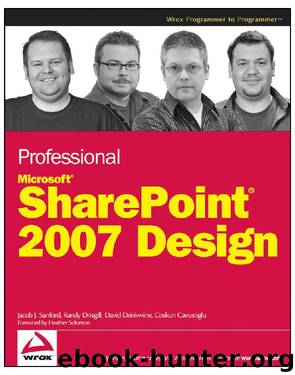Professional SharePoint 2007 Design by Jacob Sanford & Randy Drisgill & David Drinkwine & Coskun Cavusoglu

Author:Jacob Sanford & Randy Drisgill & David Drinkwine & Coskun Cavusoglu
Language: eng
Format: epub
Publisher: John Wiley & Sons
Published: 2010-12-26T16:00:00+00:00
The Master Page Structure
Master pages are ASP.NET pages written in either VB or C# and have a file extension of “.master”. Interesting enough, the language of the master page can be different from the code of the rest of the site. Despite the fact that master pages can be written in either language, MOSS master pages are almost always written in C#. If you are more comfortable with VB, you may have a steeper learning curve when making the transition to MOSS.
To get a better idea of what a master page looks like in traditional ASP.NET, see the following very simple example:
<%@ Master Language=“C#“ %>
<!DOCTYPE HTML PUBLIC “-//W3C//DTD HTML 4.01 Transitional//EN“
“http://www.w3.org/TR/html4/loose.dtd“>
<html>
<head>
<meta http-equiv=“Content-Type“ content=“text/html; charset=utf-8“>
<title>Hello World Site</title>
<link rel=“stylesheet“ href=“myStyle.css“ type=“text/css“/>
</head>
<body>
<form id=“form1“ runat=“server“>
<div id=“divMain“>
<!-- This will be overridden by the content page main content -->
<asp:ContentPlaceHolder ID=“MainBody“ runat=“server“/>
</div>
<div id=“divFooter“>
<!-- This will be overridden by the content page footer -->
<asp:ContentPlaceHolder id=“Footer“ runat=“server“/>
</div>
</form>
</body>
Download
This site does not store any files on its server. We only index and link to content provided by other sites. Please contact the content providers to delete copyright contents if any and email us, we'll remove relevant links or contents immediately.
| Coding Theory | Localization |
| Logic | Object-Oriented Design |
| Performance Optimization | Quality Control |
| Reengineering | Robohelp |
| Software Development | Software Reuse |
| Structured Design | Testing |
| Tools | UML |
Deep Learning with Python by François Chollet(14613)
The Mikado Method by Ola Ellnestam Daniel Brolund(11864)
Hello! Python by Anthony Briggs(11788)
OCA Java SE 8 Programmer I Certification Guide by Mala Gupta(11239)
Dependency Injection in .NET by Mark Seemann(10999)
Algorithms of the Intelligent Web by Haralambos Marmanis;Dmitry Babenko(9831)
The Well-Grounded Java Developer by Benjamin J. Evans Martijn Verburg(9420)
Grails in Action by Glen Smith Peter Ledbrook(9161)
Secrets of the JavaScript Ninja by John Resig Bear Bibeault(8593)
Test-Driven iOS Development with Swift 4 by Dominik Hauser(8307)
Becoming a Dynamics 365 Finance and Supply Chain Solution Architect by Brent Dawson(7974)
Microservices with Go by Alexander Shuiskov(7743)
Practical Design Patterns for Java Developers by Miroslav Wengner(7633)
Test Automation Engineering Handbook by Manikandan Sambamurthy(7584)
Kotlin in Action by Dmitry Jemerov(7262)
Angular Projects - Third Edition by Aristeidis Bampakos(7065)
The Art of Crafting User Stories by The Art of Crafting User Stories(6515)
NetSuite for Consultants - Second Edition by Peter Ries(6450)
Demystifying Cryptography with OpenSSL 3.0 by Alexei Khlebnikov(6238)
